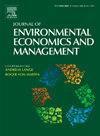货运结构转型是否能改善空气质量?——来自中国“卡车转铁路”政策的证据
IF 5.9
3区 经济学
Q1 BUSINESS
Journal of Environmental Economics and Management
Pub Date : 2025-05-09
DOI:10.1016/j.jeem.2025.103179
引用次数: 0
摘要
中国积极重塑货运体系,以应对交通运输部门造成的空气污染。本文重点研究了“卡车转铁路”(SFTR)政策,并研究了扩大铁路运输系统而限制重型卡车在公路货运中的环境后果。将高频大气污染数据与气象数据相结合,利用增强时间序列不连续回归(RDiT)分析发现,实施SFTR后,环渤海地区PM2.5、PM10和NO2浓度分别下降了13.9%、12.5%和4.2%。我们的实证研究结果经得起一种替代规范的广义差中差(DiD)方法和一系列稳健性检查。初步计算表明,环渤海地区“一带一路”的卫生效益和经济产出效益约为249.9亿美元,其中货运铁路基础设施扩建成本和企业合规成本总计40.5亿美元。本文章由计算机程序翻译,如有差异,请以英文原文为准。
Does freight structure transformation improve air quality?–Evidence from China's “shifting freight from truck to rail” policy
China proactively reshaped its freight system to combat air pollution from the transportation sector. This paper focuses on the “Shifting Freight from Truck to Rail” (SFTR) policy, and examines the environmental consequences of expanding railway transport system while curbing heavy trucks in road freight. Combine the high-frequency air pollution data with meteorology data, utilizing the augmented regression discontinuity in time-series (RDiT), we found that the implementation of SFTR led to a respective decrease of 13.9 %, 12.5 %, and 4.2 % in the concentrations of PM2.5, PM10, and NO2 in the Bohai Rim region. Our empirical findings withstand an alternative specification of generalized difference-in-differences (DiD) method and a series of robustness checks. Preliminary calculations indicate that the health and economic output benefits of SFTR in the Bohai Rim region amount to approximately $24.99 billion, with the cost of expanding freight railway infrastructure and firms’ compliance cost totaling $4.05 billion.
求助全文
通过发布文献求助,成功后即可免费获取论文全文。
去求助
来源期刊
CiteScore
8.00
自引率
4.30%
发文量
91
期刊介绍:
The Journal of Environmental Economics and Management publishes theoretical and empirical papers devoted to specific natural resources and environmental issues. For consideration, papers should (1) contain a substantial element embodying the linkage between economic systems and environmental and natural resources systems or (2) be of substantial importance in understanding the management and/or social control of the economy in its relations with the natural environment. Although the general orientation of the journal is toward economics, interdisciplinary papers by researchers in other fields of interest to resource and environmental economists will be welcomed.

 求助内容:
求助内容: 应助结果提醒方式:
应助结果提醒方式:


